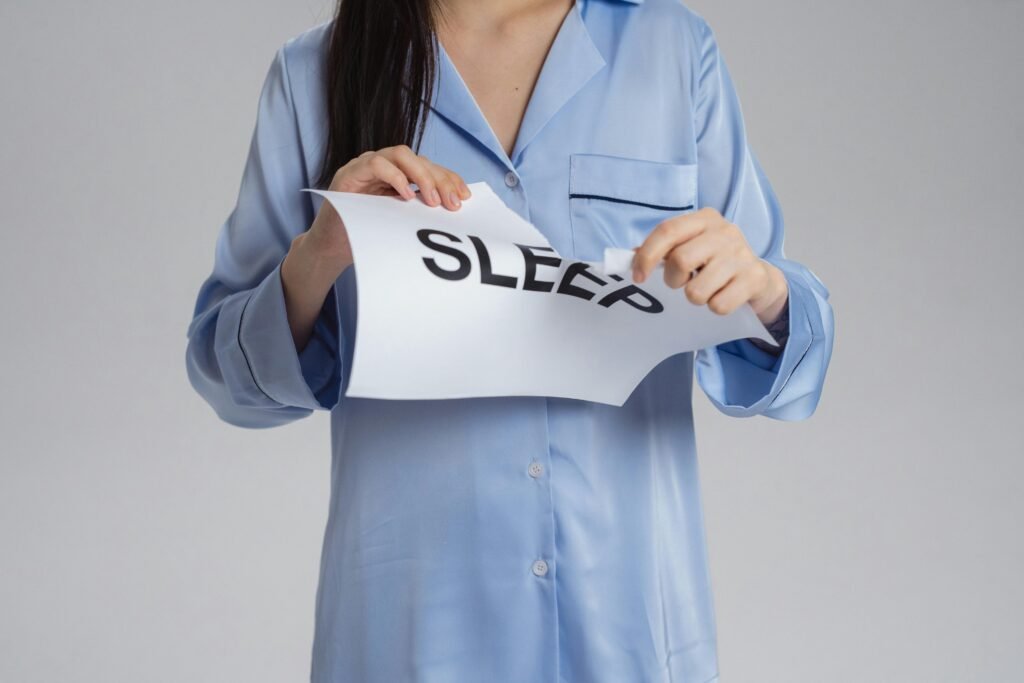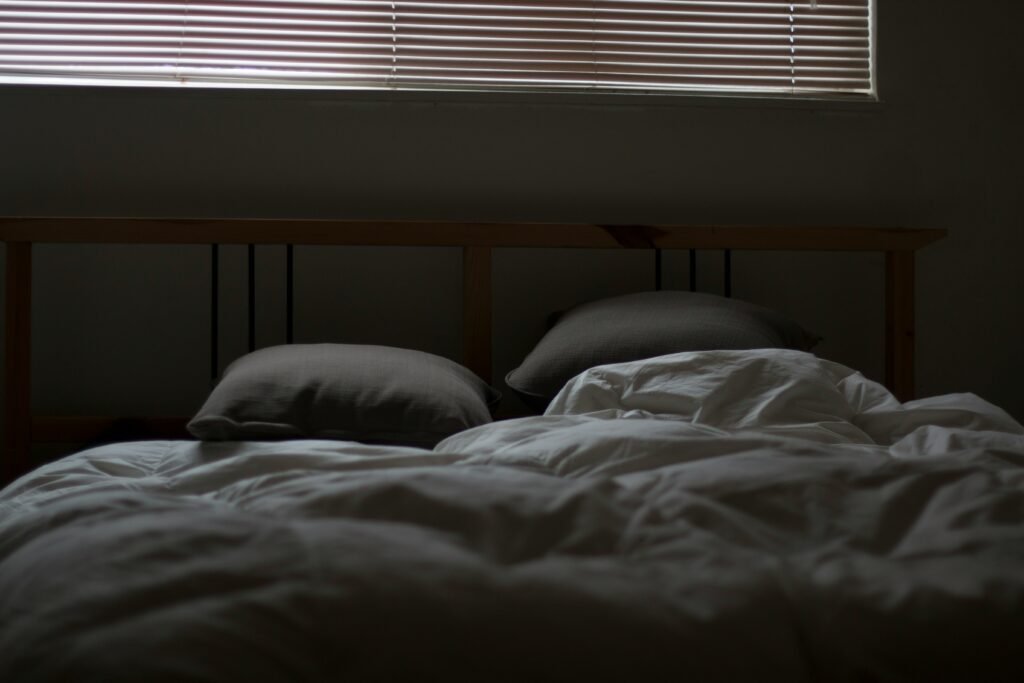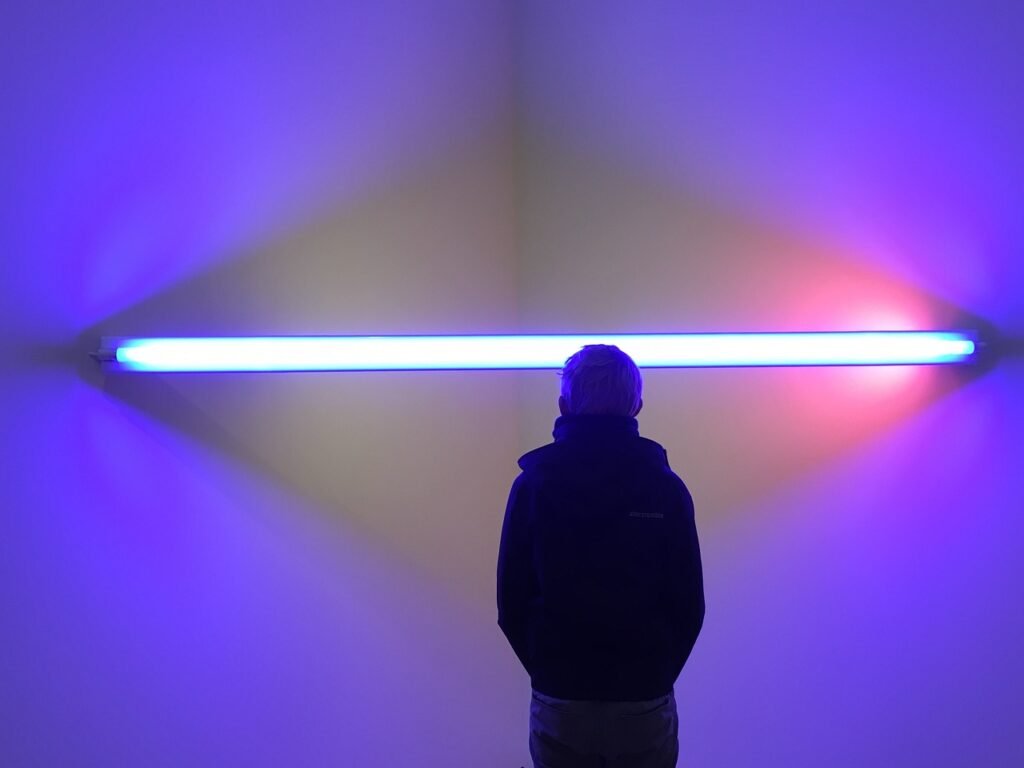
Introduction
If you are a night shift worker struggling with persistent insomnia, you know the frustration of lying in bed for hours while the rest of the world goes about their day. Your body feels exhausted after a long shift, yet your mind races and sleep remains elusive. This is not just ordinary tiredness or difficulty falling asleep. This is night shift insomnia, a complex condition that affects millions of shift workers worldwide and can seriously impact your health, job performance, and quality of life.
Night shift insomnia is different from regular sleep problems because it involves fighting against your body’s natural circadian rhythm. Your internal clock is programmed to be alert during daylight hours and sleepy when darkness falls. When you work nights and try to sleep during the day, you are essentially asking your body to do the opposite of what evolution has hardwired it to do. This creates a biological conflict that can lead to chronic sleep difficulties even when you feel physically and mentally exhausted.
The good news is that night shift insomnia is not a life sentence. With the right understanding and strategic approach, you can break the cycle of sleepless days and restless nights. The key is recognizing that this is a medical condition that requires specific interventions tailored to the unique challenges of shift work, not just general sleep advice that works for day workers.
Understanding Why Night Shift Insomnia Develops

To effectively combat night shift insomnia, you need to understand the underlying mechanisms that make it so persistent and challenging to overcome. Your circadian rhythm is controlled by a master clock in your brain called the suprachiasmatic nucleus. This biological timekeeper responds primarily to light and darkness, releasing hormones like melatonin and cortisol at specific times to regulate sleep and wakefulness.
When you work night shifts, several things happen that disrupt this natural process. First, exposure to artificial light during your shift suppresses melatonin production, the hormone that makes you feel drowsy. Even after your shift ends, your melatonin levels may remain low because your body associates daylight with alertness, not sleep time.
Simultaneously, your cortisol levels, which normally peak in the morning to help you wake up, can become dysregulated. Instead of dropping when you need to sleep during the day, cortisol may remain elevated due to the stress of working against your natural rhythm. This creates a state of physiological arousal that makes it nearly impossible to achieve deep, restorative sleep.
Your core body temperature also plays a crucial role in sleep onset. Normally, your body temperature drops slightly in the evening to signal that it is time to sleep. However, when you are trying to sleep during the day, your body temperature may be rising as part of its natural daytime pattern, sending wake-up signals instead of sleep signals to your brain.
Another factor that contributes to night shift insomnia is the accumulation of sleep pressure. Your brain produces a chemical called adenosine throughout the day, which creates the drive to sleep. Caffeine, commonly used by night shift workers to stay alert, blocks adenosine receptors, temporarily masking sleepiness. However, when the caffeine wears off adenosine levels can spike, creating an overwhelming urge to sleep at inappropriate times while potentially interfering with planned sleep periods.
Recognizing the Signs of Chronic Night Shift Insomnia

Night shift insomnia goes beyond occasional difficulty falling asleep after work. It typically involves a pattern of persistent sleep problems that occur despite adequate opportunity and environment for sleep. You may experience difficulty falling asleep within 30 minutes of lying down, frequent awakenings during your sleep period or waking up much earlier than intended and being unable to return to sleep.
The condition often manifests as non-restorative sleep where you may technically sleep for several hours but wake up feeling unrefreshed and tired. You might find yourself relying heavily on caffeine or other stimulants to function during your shifts only to feel wired and unable to sleep when you get home.
Chronic night shift insomnia also affects your mood and cognitive function. You may notice increased irritability, difficulty concentrating, memory problems or feelings of depression and anxiety. These symptoms can create a vicious cycle where worry about sleep problems actually makes it harder to fall asleep, perpetuating the insomnia pattern.
Physical symptoms are also common and may include headaches, digestive issues, frequent illnesses due to compromised immune function and changes in appetite. Your performance at work may decline and you might find yourself making more errors or having near-miss incidents due to fatigue and decreased alertness.
Creating the Optimal Sleep Environment for Day Sleeping

Your sleep environment plays a critical role in overcoming night shift insomnia. Since you are trying to sleep when the external environment is naturally stimulating wakefulness, you need to create an artificial nighttime environment that signals to your body that it is time to rest.
Light control is absolutely essential. Even small amounts of light can suppress melatonin production and interfere with sleep quality. Invest in blackout curtains that completely block daylight from entering your bedroom. If blackout curtains are not sufficient, consider blackout shades or panels that fit tightly against your windows. An eye mask can provide an additional layer of light blocking, especially if you travel or cannot completely control your sleep environment.
Temperature regulation is equally important for quality sleep. Your bedroom should be cool, ideally between 65 and 68 degrees Fahrenheit. Your body naturally drops in temperature when preparing for sleep, and a cool environment supports this process. If you cannot control the temperature in your entire home, consider using a fan, air conditioning unit, or cooling mattress pad in your bedroom.
Noise control requires special attention for day sleepers because the world around you is active and noisy during your sleep hours. Use earplugs designed for sleeping, which can reduce ambient noise significantly. White noise machines or apps can help mask irregular sounds like traffic, lawn mowers, or household activities. Some people find that consistent background noise is more effective than complete silence for maintaining sleep.
Create physical barriers between your sleep space and the active areas of your home. Use heavy curtains or room dividers to separate your bedroom from common areas. Inform family members or roommates about your sleep schedule and establish quiet hours during your sleep time. Consider using a Do Not Disturb sign on your bedroom door to remind others that you are sleeping.
Your bedroom should be reserved primarily for sleep and intimate activities. Remove televisions, computers, and other electronic devices that emit blue light or provide mental stimulation. Keep your bedroom tidy and comfortable, as a cluttered or uncomfortable space can contribute to sleep anxiety and make it harder to relax.
Developing a Consistent Pre-Sleep Routine

A structured pre-sleep routine is crucial for training your body to recognize when it is time to sleep, regardless of what time of day that occurs. Your routine should begin as soon as you arrive home from your shift and continue until you get into bed. Consistency is key as your body learns to associate these activities with the transition to sleep.
Start your routine with activities that help you decompress from work stress. This might include changing out of your work clothes, taking a warm shower or bath or doing light stretching. The warm water from a shower or bath can help lower your core body temperature when you get out mimicking the natural temperature drop that occurs before sleep.
Avoid stimulating activities during your pre-sleep routine. This includes intense exercise, exciting television shows or movies, stimulating conversations or work-related tasks. Instead, choose calming activities like reading a book, listening to soft music, gentle stretching or practicing relaxation techniques.
Limit your exposure to bright lights during your pre-sleep routine. Use dim lighting in your home when you return from work and consider wearing sunglasses during your commute home if you drive during daylight hours. This helps maintain the elevated melatonin levels that promote sleepiness.
Be mindful of your food and drink intake during your pre-sleep routine. Avoid large meals within three hours of sleep as digestion can interfere with sleep quality. Similarly, limit fluid intake to prevent frequent awakenings for bathroom visits. If you are hungry, choose a light snack that combines protein and complex carbohydrates which can promote sleepiness.
Your pre-sleep routine should also include preparing your sleep environment. Close curtains, adjust the temperature, turn on white noise, and eliminate any sources of light or distraction. Having everything prepared before you get into bed helps prevent the need to get up and make adjustments once you are trying to fall asleep.
Strategic Caffeine and Substance Management

Managing your caffeine intake is crucial for breaking the night shift insomnia cycle but it requires careful timing rather than complete elimination. Caffeine has a half-life of approximately six hours meaning that half of the caffeine you consume remains in your system six hours later. For night shift workers, this means that caffeine consumed too late in your shift can still be affecting your system when you are trying to sleep.
The key to strategic caffeine use is timing your intake to maximize alertness during work while minimizing interference with sleep. Generally, you should avoid caffeine during the second half of your shift. If you work a twelve-hour shift from 7 PM to 7 AM, try to limit caffeine intake after 1 AM. For eight-hour shifts, avoid caffeine during the last four hours of work.
When you do consume caffeine choose your sources wisely. Coffee and tea provide caffeine along with other compounds that may have additional effects. Energy drinks often contain high levels of caffeine plus other stimulants that can make sleep even more difficult. Pay attention to hidden sources of caffeine including chocolate, some medications and certain soft drinks.
Consider using caffeine strategically in small doses rather than consuming large amounts at once. A small amount of caffeine every few hours during the first part of your shift may be more effective and less likely to interfere with sleep than drinking several cups of coffee in a short period.
Alcohol might seem like a solution for helping you fall asleep after a night shift but it actually worsens sleep quality and can contribute to insomnia. While alcohol may initially make you feel drowsy, it disrupts sleep architecture leading to more frequent awakenings and less restorative sleep. Alcohol also interferes with REM sleep which is crucial for mental restoration and mood regulation.
If you use prescription medications, discuss with your healthcare provider how your night shift schedule affects their timing and effectiveness. Some medications are designed to be taken at specific times relative to sleep and meals, and your reversed schedule may require adjustments to dosing times.
Timing Your Light Exposure for Better Sleep

Light exposure is one of the most powerful tools for managing your circadian rhythm and overcoming night shift insomnia. The key is using light strategically to promote alertness during your shift and sleepiness when you need to rest.
During your shift, ensure you are exposed to bright light preferably light that contains blue wavelengths. Most workplace lighting is adequate, but if you work in dimly lit environments consider using a light therapy box during breaks. Bright light exposure during your shift helps suppress melatonin production and maintains alertness.
As your shift nears its end, begin reducing your light exposure to help your body prepare for sleep. Dim the lights if possible during the last hour of work, and wear sunglasses during your commute home if you travel during daylight hours. This helps preserve any melatonin that your body may be trying to produce as you prepare for sleep.
Light therapy can be particularly helpful for night shift workers struggling with insomnia. Light therapy boxes that produce 10,000 lux of light can be used strategically to help reset your circadian rhythm. The timing of light therapy is crucial and may require experimentation to find what works best for your schedule.
Some night shift workers benefit from light exposure immediately before their shift to promote alertness, while others find that light therapy a few hours before sleep helps establish a more regular sleep pattern. Keep a sleep diary to track how different light exposure patterns affect your sleep quality and daytime functioning.
Consider the color temperature of lights in your home environment. Blue light is stimulating and should be avoided during your pre-sleep routine, while red or amber light has less impact on melatonin production. Some people use blue light blocking glasses during the latter part of their shift and on their way home to minimize circadian disruption.
Managing Stress and Racing Thoughts

Stress and anxiety are common contributors to night shift insomnia as the challenges of working against your natural rhythm, managing family and social obligations and dealing with the physical demands of shift work can create chronic stress that interferes with sleep.
Racing thoughts when trying to fall asleep are particularly common among night shift workers. You may find your mind replaying events from your shift, worrying about upcoming work responsibilities or thinking about personal matters. This mental activity keeps your brain in an alert state that is incompatible with sleep.
Develop specific techniques for managing racing thoughts and stress before bed. Progressive muscle relaxation involves systematically tensing and relaxing different muscle groups throughout your body, which can help release physical tension and provide a focus point that distracts from racing thoughts.
Deep breathing exercises can activate your parasympathetic nervous system which promotes relaxation and sleepiness. Try the 4-7-8 breathing technique: inhale for four counts, hold your breath for seven counts then exhale for eight counts. Repeat this cycle several times while lying in bed.
Meditation and mindfulness practices can be particularly effective for night shift workers. Even ten minutes of guided meditation before sleep can help calm your mind and prepare your body for rest. There are many apps and online resources specifically designed for sleep meditation.
Consider keeping a journal or notepad beside your bed to write down worries or thoughts that keep you awake. Sometimes the act of writing down concerns helps your brain let go of them temporarily allowing you to focus on sleep instead of problem-solving.
If work stress is a significant contributor to your insomnia, consider speaking with your supervisor about ways to reduce job-related stressors. This might include adjusting your workload, improving workplace ergonomics or addressing interpersonal conflicts that contribute to stress.
When to Seek Professional Help

While many cases of night shift insomnia can be managed with lifestyle modifications and sleep hygiene improvements, there are times when professional medical intervention becomes necessary. Recognizing when to seek help can prevent the condition from becoming more severe and impacting your health and safety.
Consider consulting a healthcare provider if your insomnia persists despite implementing good sleep hygiene practices for several weeks. Chronic insomnia that lasts more than three months or significantly impacts your daily functioning requires professional evaluation. A healthcare provider can rule out underlying medical conditions that may be contributing to your sleep problems.
Sleep specialists who understand shift work sleep disorder can provide targeted treatments that go beyond general insomnia management. They may recommend sleep studies to evaluate your sleep architecture and identify specific issues that require intervention.
Cognitive behavioral therapy for insomnia, specifically adapted for shift workers, can be highly effective for breaking persistent insomnia patterns. This therapy addresses the thoughts and behaviors that perpetuate sleep problems and provides specific techniques for managing the unique challenges of shift work sleep.
In some cases, short-term medication may be appropriate to help reset your sleep pattern. However, sleep medications should be used cautiously and under medical supervision, as they can lose effectiveness over time and may have side effects that affect your work performance.
If you experience symptoms of depression, anxiety, or other mental health conditions alongside your insomnia, addressing these underlying issues is crucial for improving your sleep. Mental health professionals who understand the challenges of shift work can provide appropriate treatment and support.
Creating Your Personalized Insomnia Recovery Plan

Breaking the cycle of night shift insomnia requires a personalized approach that takes into account your specific work schedule, home environment and individual sleep needs. Start by keeping a detailed sleep diary for at least two weeks, tracking your sleep and wake times, caffeine intake, light exposure, stress levels and sleep quality.
Use this information to identify patterns and potential triggers for your insomnia. You may discover that certain foods, activities, or stressors consistently interfere with your sleep, or that specific interventions are particularly helpful for your situation.
Implement changes gradually rather than trying to overhaul your entire routine at once. Choose one or two strategies to focus on initially, and give them time to work before adding additional interventions. This approach helps you identify which strategies are most effective for your individual situation.
Be patient with the process as it can take several weeks for your body to adjust to new sleep routines and for circadian rhythm changes to take effect. Consistency is more important than perfection, and small improvements in sleep quality can compound over time to create significant changes in your overall sleep health.
Remember that managing night shift insomnia is an ongoing process, not a one-time fix. Your sleep needs and challenges may change over time due to factors like aging, health changes, or modifications to your work schedule. Stay flexible and be willing to adjust your approach as needed to maintain healthy sleep patterns throughout your shift work career.
